Title: Man Clones Best Friend: Tom Brady’s New Pup Is a Copy of the Original
In an era where science fiction increasingly blurs with reality, cloning isn’t just for high-end livestock or endangered species anymore. Former NFL superstar, Tom Brady, renowned for his unparalleled career with the New England Patriots and Tampa Bay Buccaneers, has recently made headlines not for his exploits on the field, but for a decision that underscores a growing trend among pet owners: pet cloning.
According to reports, Brady has welcomed a new puppy into his home, a precise genetic clone of his previous dog, which had been a beloved member of the Brady family. This decision marks Brady as one of the increasing number of pet owners who choose to clone their pets, seeking to preserve more than just memories of their furry friends.
The Science Behind Pet Cloning
Pet cloning is a complex process that involves harvesting the DNA of the original animal to produce a genetically identical copy. This is typically achieved through a method known as somatic cell nuclear transfer (SCNT). In this process, scientists transfer the nucleus of a somatic cell, which contains almost all of the pet’s DNA, into an egg cell from which the nucleus has been removed. This cell is stimulated to divide and develop into an embryo, which is then implanted into a surrogate mother.
Despite the identical genetic makeup, cloned pets might not necessarily exhibit the same personality or even the same physical traits completely, as these can be influenced by factors other than genetics such as environment and upbringing.
Ethical and Societal Implications
The decision to clone a pet often brings with it a slew of ethical questions. Critics argue that pet cloning may contribute to animal overpopulation issues, diverting attention and resources away from millions of animals in shelters in need of homes. Furthermore, the cloning process itself raises animal welfare concerns; the success rate can be low, and the procedure can lead to high rates of miscarriage and birth defects in surrogate animals.
Nevertheless, advocates of pet cloning argue that the practice is a personal decision made by pet owners who are seeking to cope with the loss of their pet. In many ways, this can be seen as a natural extension of the human desire to hold on to the things we cherish.
Cloning in Pop Culture and Beyond
Tom Brady’s situation brings the concept of pet cloning into the mainstream, echoing scenarios more commonly found in science fiction. It raises broader questions about the future of cloning technology and its potential implications for society. Could the adoption of such technology by high-profile individuals lead to wider societal acceptance of cloning practices?
Moreover, Brady’s case is not an isolated one. He joins celebrities like Barbra Streisand and Simon Cowell, who have also opted to clone their pets, signaling a potential shift in perception towards this technology among the public.
Final Thoughts
As we observe the impact of these technological advancements, it’s essential to balance the marvels of scientific capabilities with ethical considerations. While cloning might be seen as an homage to a beloved pet, it also necessitates a broader dialogue about the implications for animal welfare and genetic diversity.
Whatever one’s stance might be on this issue, it’s clear that pet cloning, as showcased by Tom Brady’s decision, is a phenomenon that won’t merely fade away; it will likely ignite ongoing debates that challenge our perceptions of nature, companionship, and life itself. As we tread into these uncharted territories, it is critical to guide our decisions with compassion, consideration, and care for all living beings involved.
Last updated on November 7th, 2025 at 01:27 am
🟣 Bpaynews Analysis
This update on Tom Brady Clones Beloved Dog: Meet the Identical New Pup sits inside the Latest News narrative we have been tracking on 2 weeks ago. Our editorial view is that the market will reward projects/sides that can show real user activity and liquidity depth, not only headlines.
For Google/News signals: this piece adds context on why it matters now, how it relates to recent on-chain moves, and what traders should watch in the next 24–72 hours (volume spikes, funding rates, listing/speculation, or regulatory remarks).
Editorial note: Bpaynews republishes and rewrites global crypto/fintech headlines, but every post carries an added value paragraph so it isn’t a 1:1 copy of the source.



